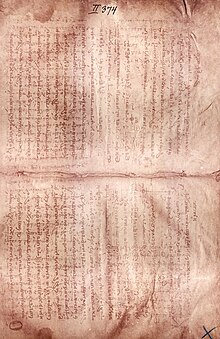
Back طرسية أرخميدس Arabic Архимедов палимпсест Bulgarian Palimpsest d'Arquimedes Catalan Archimédův palimpsest Czech Arkimedes' Palimpsest Danish Archimedes-Palimpsest German Παλίμψηστο του Αρχιμήδη Greek Palimpsesto de Arkimedo Esperanto Palimpsesto de Arquímedes Spanish Arkimedesen palinpsestoa Basque


The Archimedes Palimpsest is a parchment codex palimpsest, originally a Byzantine Greek copy of a compilation of Archimedes and other authors. It contains two works of Archimedes that were thought to have been lost (the Ostomachion and the Method of Mechanical Theorems) and the only surviving original Greek edition of his work On Floating Bodies.[1] The first version of the compilation is believed to have been produced by Isidore of Miletus, the architect of the geometrically complex Hagia Sophia cathedral in Constantinople, sometime around AD 530.[2] The copy found in the palimpsest was created from this original, also in Constantinople, during the Macedonian Renaissance (c. AD 950), a time when mathematics in the capital was being revived by the former Greek Orthodox bishop of Thessaloniki Leo the Geometer, a cousin of the Patriarch.[3]
Following the sack of Constantinople by Western crusaders in 1204, the manuscript was taken to an isolated Greek monastery in Palestine, possibly to protect it from occupying crusaders, who often equated Greek script with heresy against their Latin church and either burned or looted many such texts (including two additional copies of Archimedes writing, at least).[4][5] The complex manuscript was not appreciated at this remote monastery and was soon overwritten (1229) with a religious text.[6] In 1899, nine hundred years after it was written, the manuscript was still in the possession of the Greek church, and back in Istanbul, where it was catalogued by the Greek scholar Papadopoulos-Kerameus, attracting the attention of Johan Heiberg. Heiberg visited the church library and was allowed to make detailed photographs in 1906. Most of the original text was still visible, and Heiberg published it in 1915.[7] In 1922 the manuscript went missing in the midst of the evacuation of the Greek Orthodox library in Istanbul, during a tumultuous period following World War I.[8] A Western businessman concealed the book for over 70 years, and at some point forged pictures were painted on top of some of the text to increase resale value.[8] Unable to sell the book privately, in 1998 the businessman's daughter risked a public auction in New York contested by the Greek church; the U.S. court ruled for the auction, and the manuscript was purchased by an anonymous buyer (rumored to be Jeff Bezos).[9] The texts under the forged pictures, as well as previously unreadable texts, were revealed by analyzing images produced by ultraviolet, infrared, visible and raking light, and X-ray.
All images and transcriptions are now freely available on the web at the Archimedes Digital Palimpsest under the Creative Commons License CC BY.[10][11][12]

- ^ Morelle, Rebecca (2007-04-26). "Text Reveals More Ancient Secrets". BBC News. Archived from the original on 19 February 2009. Retrieved 2009-03-31.
- ^ "Editions of Archimedes' Work". Brown University Library. Archived from the original on 8 August 2007. Retrieved 2007-07-23.
- ^ Reviel Netz, William Noel and Nigel Wilson. The Archimedes Palimpsest, Vol. 1. Catalogue and Commentary, Cambridge University press, 2011.
- ^ Murray, Stuart (2009). The Library. ISBN 9781602397064. Archived from the original on 2023-04-22. Retrieved 2020-10-29.
- ^ World Encyclopedia of Library and Information Services. 1993. ISBN 9780838906095. Archived from the original on 2023-04-22. Retrieved 2020-10-29.
- ^ Bergmann, Uwe. "X-Ray Fluorescence Imaging of the Archimedes Palimpsest: A Technical Summary" (PDF). Archived (PDF) from the original on 2017-05-18. Retrieved 2013-09-29.
- ^ The Archimedes Palimpsest Project. "The History of the Archimedes Manuscript". Archived from the original on 2018-10-01. Retrieved 2015-03-16.
- ^ a b Schulz, Matthias (June 22, 2007). "Revolutionary? Authentic? Stolen? The Story of the Archimedes Manuscript". Der Spiegel. Archived from the original on April 2, 2015. Retrieved March 16, 2015.
- ^ Hirshfeld, Alan (2009). Eureka Man. Walker & Co, NY. p. 187. ISBN 9780802719799. Archived from the original on 2023-04-22. Retrieved 2013-09-29.
- ^ "The Archimedes Palimpsest". University of Pennsylvania Libraries. Archived from the original on 2019-02-07. Retrieved 2016-08-01.
All materials on OPenn are in the public domain or released under Creative Commons licenses as Free Cultural Works
- ^ "Reading Between the Lines, Smithsonian Magazine". Archived from the original on 2008-01-19. Retrieved 2009-03-31.
- ^ "archimedespalimpsest". Archived from the original on 21 February 2009.
This data is released for use under a Creative Commons license, with attribution
© MMXXIII Rich X Search. We shall prevail. All rights reserved. Rich X Search